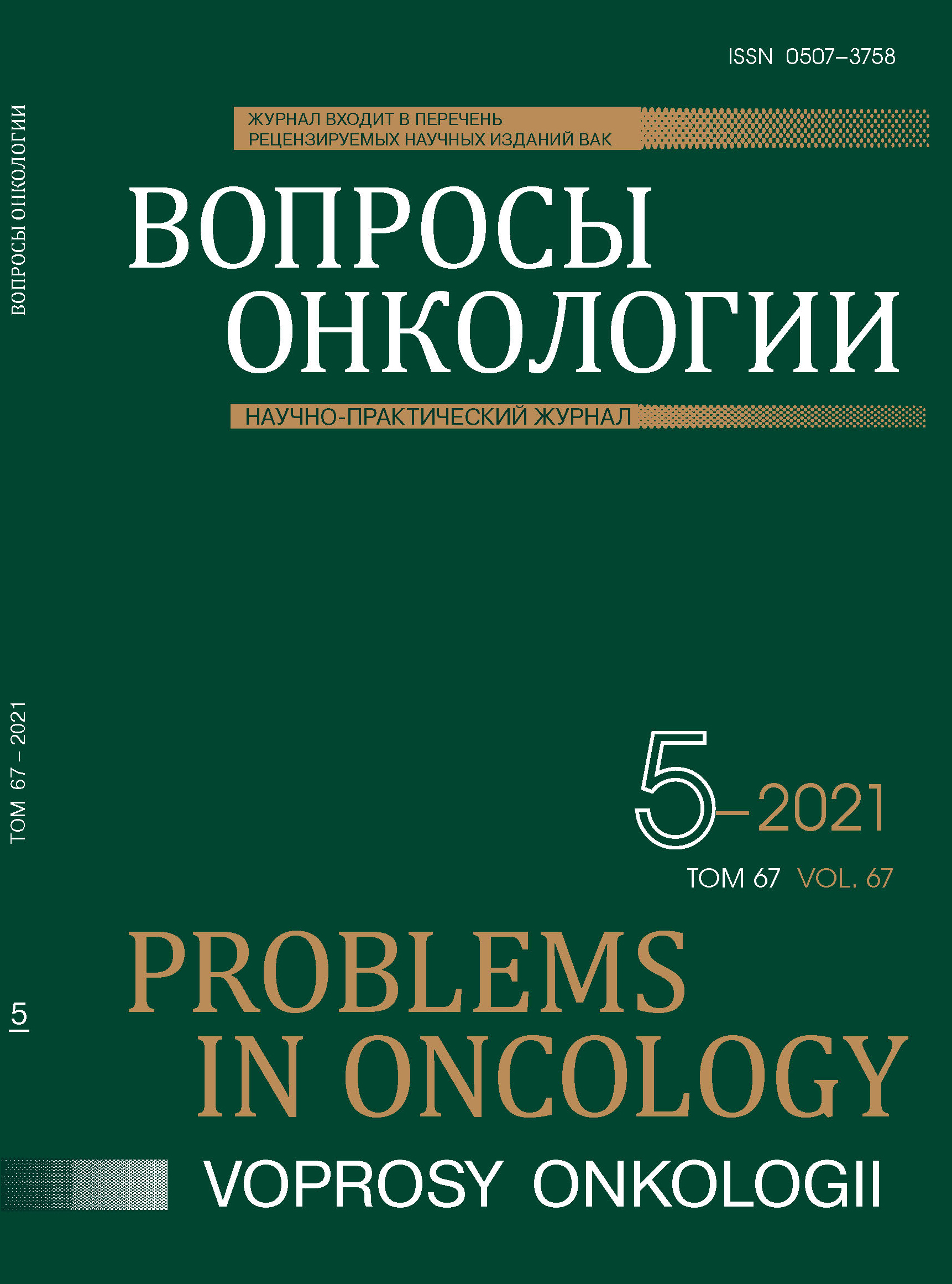Abstract
Purpose: Assessment of the comparative radiosensitivity of bone metastases of various nature and histogenesis.
Material/methods: As part of a randomized study, 810 courses of 3D-conformal or IMRT / VIMAT radiotherapy were performed for bone metastases of various origins and localization with persistent pain syndrome. Radiotherapy protocol included hypofractionation regimes of 2, 3 or 4 fractions of 6,5 Gy with total dose of 13-26 Gy or standard fractionation regime with total dose of 46 Gy.
Results: The overall effectiveness (сomplete and partial pain relief) of radiotherapy was 96.2%, complete response rate (CRR) – 56.2%, partial response rate – 40.0%. Pain relapse rate was 8.6%, on average after 9.5 months after irradiation. The independent predictors of the CRR were: the initial pain intensity [hazard ratio (RR): 0.48, confidence interval (CI): 0.40-0.58; p = 0.0001], dose/number of fractions (RR: 1.26, CI: 1.07-1.50; p = 0.0059) and primary tumor site (RR: 0.95, CI: 0.92-0,99; p = 0.0053). We constructed a scale of comparative radiosensitivity of bone metastases of various primary tumors, taking into account the complete response rate and the probability of surviving without pain relapse for 6, 12 and 24 months after radiotherapy. The radiosensitive group included metastases from breast and prostate cancer, melanoma, bladder and PNET (CRR 60% or more), and relatively radioresistant group - metastases from unknown origin, colon, stomach and kidney cancer (CRR 40% or less).
Conclusion: More than 95% overall effectiveness of radiotherapy for bone metastases, with pain relapse rate of less than 10% of cases, allows us to consider widefield irradiation in doses of 19.5-26 Gy, in 3-4 fractions of 6.5 Gy, the preferred treatment for multifocal lesions. Dose escalation in patients with bone metastases of kidney, colon, lung cancer and metastases from unknown origin seems to be justified in the cases with a life expectancy of more than a year.
References
Mantel F, Glatz S, Toussaint A et al. Long-term safety and efficacy of fractionated stereotactic body radiation therapy for spinal metastases // Strahlenther Onkol. 2014;190(12):1141–8. https://doi:10.1007/s00066-014-0706-1
Erler D, Brotherston D, Sahgal A. Local control and fracture risk following stereotactic body radiation therapy for non-spine bone metastases // Radiother Oncol. 2018;127(2):304–309. https://doi:10.1016/j.radonc.2018.03.030
Sze WM, Shelley M, Held I et al. Palliation of metastatic bone pain: singl fraction versus multiple-fraction radiotherapy — a systematic review of randomised trials // Clin Oncol. 2003;15(6):345–352. https://doi:10.1016/s0936-6555(03)00113-4
Wu J, Wong R, Johnston M et al. Meta-analisis of dose- fractionation radiotherapy trials for the palliation of painful bone metastases // Int J Radiat Oncol Biol Phys. 2003;55(3):594–605. https://doi:10.1016/s0360-3016(02)04147-0
Takahashi Т, Nishimura К, Yamano T, Gika M. Role of Palliative Radiotherapy for Bone Metastasis // J Palliat Care Med. 2014;4:171. https://doi:10.4172/2165-7386.1000171
Бычкова Н.М., Хмелевский Е.В. Особенности метастатического поражения костей при различных первичных опухолях и их значение для дистанционной лучевой терапии // Онкология. Журнал им. П.А. Герцена. 2016;5(6):12 [Bychkova N.M., Khmelevsky EV. Features of metastatic bone involvement in different primary tumors and their implications for external beam radiotherapy // Onkologiya Zhurnal imeni P.A. Gertsena 2016;5(6):12. (In Russ.)] https://doi.org/10.17116/onkolog20165612-20
World Health Organization (1979) WHO Handbook for reporting results of cancer treatment. WHO Publication № 48, Geneva. https://doi:apps.who.int/iris/handle/10665/37200
Amundson S, Do K, Vinikoor L et al. Integrating global gene expression and radiation survival parameters across the 60 cell lines of the National Cancer Institute Anticancer Drug Screen // Cancer Res. 2008;68(2):415–24. https://doi:10.1158/0008-5472.CAN-07-2120
D'Andrea FP, Safwat A, Burns JS et al. Tumour microenvironment and radiation response in sarcomas originating from tumourigenic human mesenchymal stem cells // Int J Radiat Biol. 2012;88(6):457–65. https://doi:10.3109/09553002.2012.683509
Hill RP. The changing paradigm of tumor response to irradiation // Br J Radiol. 2017;90:20160474. https://doi.org/10.1259/bjr.20160474
He Q, Tong Y, Ye Z et al. A multiple genomic data fused SF2 prediction model, signature identification, and gene regulatory network inference for personalized radiotherapy // Technol Cancer Res Treat. 2020;19:1533033820909112. https://doi:10.1177/1533033820909112
Shahbazian D, Bindra R, Kluger H, Glazer P. Radiation sensitivity and sensitization in melanoma // Pigment Cell Melanoma Res. 2013;26(6):928–30. https://doi:10.1111/pemr.12147
Sambade M, Peters E, Thomas N et al. Melanoma cells show a heterogeneous range of sensitivity to ionizing radiation and are radiosensitized by inhibition of B-RAF with PLX-4032 // Radiother Oncol. 2011;98(3):394–9. https://doi:10.1016/j.radonc.2010.12.017
Overgaard J. The role of radiotherapy in recurrent and metastatic malignant melanoma: a clinical radiobiological study // Int J Radiat Oncol Biol Phys. 1986;12(6):867–872. https://doi:10.1016/0360-3016(86)90378-0

This work is licensed under a Creative Commons Attribution-NonCommercial-NoDerivatives 4.0 International License.
© АННМО «Вопросы онкологии», Copyright (c) 2021
